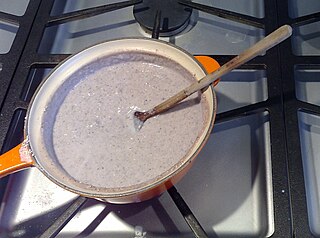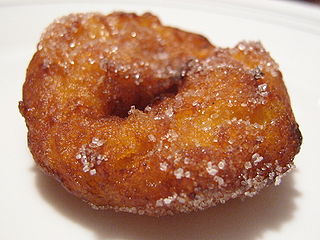 W
WMost traditional foods in Guatemalan cuisine are based on Maya cuisine, with Spanish influence, and prominently feature corn, chilies and beans as key ingredients. Guatemala is famously home to the Hass avocado and the birthplace of chocolate, as first created by the Maya.
 W
WAtole, also known as atolli and atol de elote, is a traditional hot corn- and masa-based beverage of Mexican origin. Chocolate atole is known as champurrado or atole. It typically accompanies tamales, and is very popular during Day of the Dead and Las Posadas.
 W
WA buñuelo is a fried dough fritter found in Spain, Latin America, Israel, and other regions with a historical connection to Spaniards or Sephardic Jews, including Southwest Europe, the Balkans, Anatolia, and other parts of Asia and North Africa. Buñuelos are traditionally prepared at Christmas, Ramadan, and among Sephardic Jews at Hanukkah. It will usually have a filling or a topping. In Mexican cuisine, it is often served with a syrup made with piloncillo.
 W
WChicharrón is a dish generally consisting of fried pork belly or fried pork rinds. Chicharrón may also be made from chicken, mutton or beef.
 W
WChurrasco is the Portuguese and Spanish name for beef or grilled meat more generally. It is a prominent feature in the cuisine of Brazil, Uruguay and Argentina. The related term churrascaria is mostly understood to be a steakhouse.
 W
WCooking bananas are banana cultivars in the genus Musa whose fruits are generally used in cooking. They may be eaten ripe or unripe and are generally starchy. Many cooking bananas are referred to as plantains or green bananas. In botanical usage, the term "plantain" is used only for true plantains, while other starchy cultivars used for cooking are called "cooking bananas". True plantains are cultivars belonging to the AAB Group, while cooking bananas are any cultivars belonging to AAB, AAA, ABB, or BBB groups. The currently accepted scientific name for all such cultivars in these groups is Musa × paradisiaca. Fe'i bananas from the Pacific Islands are often eaten roasted or boiled, and are thus informally referred to as "mountain plantains," but they do not belong to any of the species from which all modern banana cultivars are descended.
 W
WIn North America, a corn tortilla or just tortilla is a type of thin, unleavened flatbread, made from hominy, that is the whole kernels of maize treated with alkali to improve their nutrition in a process called nixtamalization. A simple dough made of ground, dried hominy, salt and water is then formed into flat discs and cooked on a very hot surface, generally an iron griddle called a comal.
 W
WCurtido is a type of lightly fermented cabbage relish. It is typical in Salvadoran cuisine and that of other Central American countries, and is usually made with cabbage, onions, carrots, oregano, and sometimes lime juice; it resembles sauerkraut, kimchi, or tart cole slaw. It is commonly served alongside pupusas, the national delicacy.
 W
WEscabeche is the name for a number of dishes in Spanish, Portuguese, Filipino and Latin American cuisines, consisting of marinated fish, meat or vegetables, cooked in an acidic sauce, and colored with paprika, citrus, and other spices.
 W
WFernaldia pandurata is a vine with edible flowers, widespread in El Salvador, Guatemala, and other countries in Central America.
 W
WFiambre is a traditional Guatemalan salad that is prepared and eaten yearly to celebrate the Day of the Dead and the All Saints Day. It is served chilled and may be made with dozens of ingredients.
 W
WFrijoles negros is a Latin American dish made with black beans, prepared in Guatemala, Cuba, Venezuela, Puerto Rico, Mexico, and other nations in Latin America. The black bean, a legume of the species Phaseolus vulgaris, is usually purchased in either canned or dried form. One cup of dried black beans yields approximately 2+1⁄2 cups of cooked beans. Black bean soup is another commonly prepared Cuban favorite.
 W
WGarnachas are a traditional dish composed of fried corn tortillas topped with refried beans, shredded cabbage, cheese, and other garnishes. Garnaches are especially popular in Belize, where they are made with corn, beans, and cheese being the traditional make up, and Guatemala, being available in most restaurants as a common appetizer.
 W
WHilachas is a dish originating in Guatemalan cuisine that is similar to ropa vieja. It generally consists of boiled, shredded beef served with tomato sauce and tomatillo, potatoes, carrots and Guajillo chiles. The name translates to "rags" and is very common throughout Central America.
 W
WHumita is a Native South American dish from pre-Hispanic times, a traditional food from the Andes and it can be found in Bolivia, Chile, Ecuador, Peru, and Northwest Argentina. It consists of fresh choclo pounded to a paste, wrapped in a fresh corn husk, and slowly steamed or boiled in a pot of water. In Bolivia it is known as huminta and in Brazil as pamonha. Humitas are similar to Mexican uchepos, which are also made with fresh corn; but they are only superficially similar to tamales, which are made with nixtamalized corn (masa).
 W
WMilhojas are desserts made with stacked layers of puff pastry, filled with creme patissiere; cream; dulce de leche; a creamy mix of condensed milk, sugar, and vanilla; or white chocolate. They are part of the cuisines of Argentina, Bolivia, Ecuador, Colombia, Chile, El Salvador, Guatemala, Mexico, Peru, Portugal, Spain, UK (Gibraltar), Uruguay, and Venezuela.
 W
WPan de muerto, is a type of pan dulce traditionally baked in Mexico during the weeks leading up to the Día de Muertos, which is celebrated from November 1st to November 2nd.
 W
WRellenitos de plátano is a dish of sweet mashed plantains stuffed with a mixture of refried beans, chocolate, and cinnamon. The assembled egg-shaped balls are deep-fried, and then served with either powdered sugar or honey on top. It is a common and very popular dessert in the cuisine of Guatemala.
 W
WA tamale is a traditional Mesoamerican dish, made of masa or dough, which is steamed in a corn leaf or banana leaf. The wrapping can either be discarded prior to eating or used as a plate. Tamales can be filled with meats, cheeses, fruits, vegetables, chilies or any preparation according to taste, and both the filling and the cooking liquid may be seasoned.
 W
WTiky is a pineapple-flavored soft drink distributed by Fabrica de Bebidas Gaseosas Salvavidas, S.A. in Guatemala.
 W
WA tortilla is a thin, circular unleavened flatbread originally made from maize hominy meal, and now also from wheat flour. The Aztecs and other Nahuatl speakers called tortillas tlaxcalli. First made by the indigenous peoples of Mesoamerica before colonization, tortillas are a cornerstone of Mesoamerican cuisine. Corn tortillas in Mesoamerica are evidenced from as early as 500 BCE.
 W
WTostones are twice-fried plantain slices commonly found in Latin American cuisine and Caribbean cuisine. Most commonly known as tostones, Puerto Rico, Jamaica, Nicaragua, Cuba, Honduras and Venezuela, they are also known as tachinos or chatinos (Cuba), platano frito or frito verde, bananes pesées (Haiti), patacones and, sometimes, patacón pisao in Colombia.